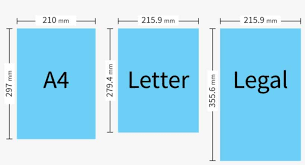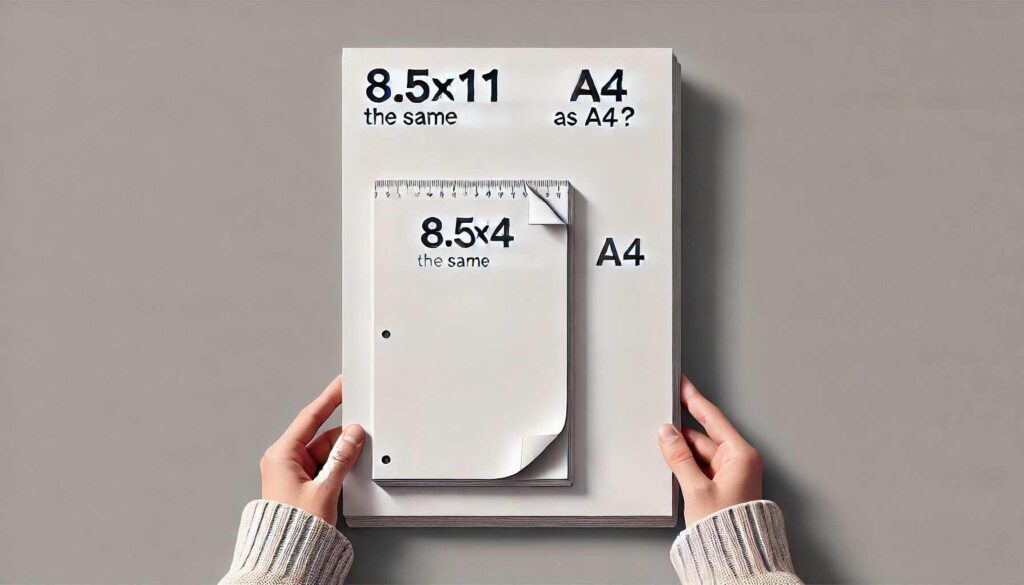I once printed a document, and it looked terrible because I used the wrong paper size. Now, I’ll share simple tips to help you choose the right size easily.
printer paper size ( short answer )
Printer paper sizes are different worldwide. A4 (210mm x 297mm) is used globally, while Letter (8.5 x 11 inches) is common in the USA. Pick the size wisely!
In this article we will discuss printer paper size.
What Is Standard Paper Size?

Standard paper size refers to the regular dimensions used for printing documents. The most common size worldwide is A4 (210mm x 297mm). In some countries like the USA, Letter size (8.5 x 11 inches) is more popular. Using the correct paper size ensures your prints are properly formatted.
What Is A Normal Printer Paper Size?
The most common printer paper size is Letter size (8.5 x 11 inches) in the United States and A4 size (210 x 297 mm) internationally. These sizes are typically used for printing documents like letters, reports, and forms.
What Are The Different Sizes Of Paper?
There are different paper sizes used for printing. The most common size is A4 (210mm x 297mm), used worldwide. Other sizes include A3 for large prints, Letter for office documents, and Legal for contracts. Choose based on your needs:
- A4 (210mm x 297mm) – Perfect for most documents like letters, reports, and school papers.
- Letter (8.5 x 11 inches) – Common in the USA, used for business documents and forms.
- A3 (297mm x 420mm) – Great for printing large designs, posters, or presentations.
- Legal (8.5 x 14 inches) – Best for contracts and legal documents requiring extra space.
- Tabloid (11 x 17 inches) – Used for newsletters, magazines, or large-format printing.
Choosing the correct size helps keep your documents clear and professional.
What Size is 8.5 by 11?

The size 8.5 x 11 inches is called Letter size in the United States. It is the most commonly used printer paper size for everyday printing, including letters, reports, and general documents.
Traditional North American Paper Sizes
The North American standard uses specific formats and aspect ratios for paper sizes. Below is a helpful chart summarizing the most commonly used paper sizes in the United States and Canada:
| Format | Size in Inches | Size in Millimeters |
| Letter | 8.5 x 11 | 216 x 279 |
| Legal | 8.5 x 14 | 216 x 356 |
| Tabloid (Ledger) | 11 x 17 | 279 x 432 |
These sizes are widely used for various purposes, from office documents to larger prints like posters and newsletters.
How Were Standard Paper Sizes Determined?
Today’s paper sizes come from history and practicality. The ISO 216 standard, introduced in 1975, established A4 (210 x 297 mm) as the international standard. In the USA, Letter size (8.5 x 11 inches) became official in the 1980s under President Reagan, replacing older sizes used for government documents.
How To Print A4 Documents?
Printing A4 documents is simple if you follow these steps:
- Check Printer Compatibility: Ensure your printer supports A4 paper size.
- Load A4 Paper: Place A4 paper (210 x 297 mm) in the tray and adjust the guides.
- Set Page Size: In your document settings, select A4 under “Page Setup” or “Print Setup.”
- Adjust Printer Settings: Choose A4 as the paper size in the printer’s print menu.
- Preview and Print: Use print preview to check alignment, then click “Print.”
By following these steps, you can print professional-looking A4 documents with ease!
What Size Paper Do Printers Use?
Printers usually use common paper sizes based on the region. Globally, A4 (210 x 297 mm) is the standard for documents. In the USA, Letter size (8.5 x 11 inches) is popular. Some printers also support Legal (8.5 x 14 inches) or A3 (297 x 420 mm) for larger prints.
Why Do Different Countries Use Different Paper Sizes?
Countries use different paper sizes because of historical reasons and local needs. Most countries follow the A-series (like A4), based on a simple ratio, while the USA uses Letter size (8.5 x 11 inches). These differences come from each region’s printing practices and history.
Read Also: Printer Proxy Is Trying To Modify The Printer Settings – Fix Proxy 2025!
Standard Iso Paper Sizes

The ISO 216 standard defines paper sizes used in most countries around the world, excluding the USA and Canada. The most common sizes in the A-series are:
- A0: The largest size, measuring 841 x 1189 mm, used for large posters and technical drawings.
- A1: Half the size of A0, measuring 594 x 841 mm, used for blueprints and large charts.
- A2: 420 x 594 mm, often used for posters, architectural drawings, and artwork.
- A3: 297 x 420 mm, typically used for presentations and newspapers.
- A4: 210 x 297 mm, the most commonly used paper size for documents, letters, and office printing.
- A5: 148 x 210 mm, often used for booklets, flyers, and small notebooks.
- A6: 105 x 148 mm, typically used for postcards and small invitations.
- A7: 74 x 105 mm, used for small notepads and tickets.
These sizes follow a consistent ratio (1:√2), making it easy to scale documents up or down without losing proportions.
Non-Standard Paper Sizes And Their Uses

While standard paper sizes like A4 and Letter are commonly used, there are also non-standard paper sizes that cater to specific needs or regional preferences. These include:
- Legal Size (8.5 x 14 inches): Used for legal documents, contracts, and agreements in the USA.
- Tabloid (11 x 17 inches): Ideal for newspapers, posters, and large presentations.
- Executive (7.25 x 10.5 inches): Used for business correspondence and premium letters.
- B-series Sizes (B4, B5, etc.): Common for books, invitations, and certificates.
- Custom Sizes: Used for specialized projects like photography, artwork, and graphic design.
How To Choose The Right Size Of Paper When Printing
When selecting the right paper size for printing, it’s important to consider the following factors:
1. Document Purpose:
- Use A4 or Letter (8.5 x 11 inches) for standard letters, reports, and forms.
- Choose A3 or Tabloid (11 x 17 inches) for presentations, posters, and large graphics.
- Opt for Legal size (8.5 x 14 inches) when printing contracts or documents that need extra space.
2. Printer Specifications:
- Supported Paper Sizes: Refer to your printer’s manual to know the sizes it supports. Most printers work with Letter and Legal, but larger sizes like Tabloid and A3 may need special features.
- Paper Trays: Make sure your printer has the appropriate tray or feeder to accommodate larger paper sizes.
- Finishing Tools: If using tools like staplers, binders, or folders, check their size compatibility to ensure professional finishing for your documents.
What’s With The Weird Numbers?
The “A” numbers, like A4 and A3, are part of the ISO 216 paper size system, used worldwide. They follow a 1:√2 ratio, so each size can be easily scaled up or down. For example, cutting A4 paper in half gives you A5 paper.
How Did We Get Standard Printer Paper Sizes?
Standard paper sizes were created for consistency in printing. The ISO 216 system, used globally, introduced the A-series (like A4) with a simple 1:√2 ratio for easy scaling. In the USA, sizes like Letter (8.5 x 11 inches) developed from older paper-making methods.
Why Is Understanding Paper Sizes Important?
Understanding paper sizes ensures professional-looking documents, smooth printing, and consistent formatting. Here’s why it matters:
- Professional Appearance: Correct paper size ensures your documents and images look clean and well-aligned.
- Print Quality: Prevents issues like misaligned text, cut-off graphics, and poor print quality.
- Printer Health: Reduces the risk of paper jams and printer errors, prolonging the printer’s life.
- Consistency: Ensures documents are formatted correctly, especially for international clients, maintaining a professional image.
What is the advantage of the A-series paper sizes?
The A-series paper sizes offer several practical advantages for printing and document handling:
- Consistent Ratio (1:√2): Ensures easy scaling of documents without altering proportions.
- Flexible Sizes: Cutting one size in half creates the next smaller size (e.g., A4 to A5).
- Global Standard: Widely used across most countries, ensuring compatibility.
- Efficient Printing: Reduces paper waste when resizing or printing.
- Versatility: Suitable for various purposes like office documents (A4), posters (A0), and booklets.
Take Control Of Your Printing – Reduce Costs And Waste With Managed Print Services
Managed Print Services (MPS) help businesses reduce printing costs, waste, and improve efficiency. MPS providers monitor and optimize your printing environment, offering solutions like cost-effective leasing, paper-saving techniques, and regular maintenance.
Tips For Choosing The Right Paper Size
- Document Type: Use A4 or Letter for standard documents, A3 or Tabloid for larger prints.
- Printer Compatibility: Make sure your printer supports the selected size.
- Preview Before Printing: Always check the document before printing to ensure it fits.
- Special Projects: Use 13 x 19 inches for high-quality prints or creative work.
Read Also: How Do I Update Windows To Print Sheet Music Properly – Update Windows Now!
Frequently Asked Questions
1. Is Normal Printer Paper A4?
No, normal printer paper in the United States is typically Letter size (8.5 x 11 inches). However, A4 size (210 x 297 mm) is the standard in many other countries, especially in Europe and Asia.
2. Is 11×17 Paper Standard?
Yes, 11×17 inches, also known as Tabloid or Ledger size, is a standard paper size used for larger prints like posters, brochures, and architectural designs. It’s less common than Letter size but still widely used in specific fields.
3. What Is The Difference Between A4 And Letter Size?
A4 size is slightly taller and narrower at 210 x 297 mm, while Letter size measures 8.5 x 11 inches (216 x 279 mm), which is shorter and wider.
4. What Is The Difference Between Legal And Letter Size?
Legal size (8.5 x 14 inches) is longer than Letter size, offering more space for contracts and detailed documents.
5. How Do I Convert Measurements Between Inches And Millimeters?
To convert, multiply inches by 25.4 to get millimeters, or divide millimeters by 25.4 to get inches.
6. How Does Paper Weight Affect Printing?
Heavier paper, measured in GSM (grams per square meter), provides better quality and durability for professional documents and photos.
7. Can I Print Custom-Sized Documents On Standard Printers?
Yes, many printers allow custom sizes, but you’ll need to adjust the settings and ensure the printer supports the chosen dimensions.
8. Why Do Printers Sometimes Jam With Certain Paper Sizes?
Printer jams can occur if the paper is improperly loaded, incompatible, or not aligned with the printer’s settings.
9. What Is The Difference Between Glossy And Matte Paper?
Glossy paper has a shiny finish, ideal for photos, while matte paper offers a non-reflective surface, suitable for text-heavy documents.
10. What Is The Largest Paper Size A Standard Printer Can Handle?
Most standard printers handle up to A4 or Letter sizes, while specialized printers can support larger sizes like A3 or Tabloid.
Conclusion
Understanding paper sizes is essential for achieving professional and well-formatted prints. Whether using standard sizes like A4 or specialized options like Legal, selecting the right size ensures clarity and precision. Knowing regional differences and printer compatibility can save time and prevent errors. By mastering these basics, you can create documents that meet global standards and professional expectations.
Read More:
- Printer Keeps Going Offline – Fix Printer 2025!
- Printer Encryption Credentials Have Expired – Update Printer Security 2025!
- What Does Filter Failed Mean On Printer Chromebook – Fix Filter Failed!
- Ricoh Independent Supplier Toner Cartridge Is Set – Upgrade Your Prints!
- Printer Queue Won’t Clear – Resolve Print Issues!
